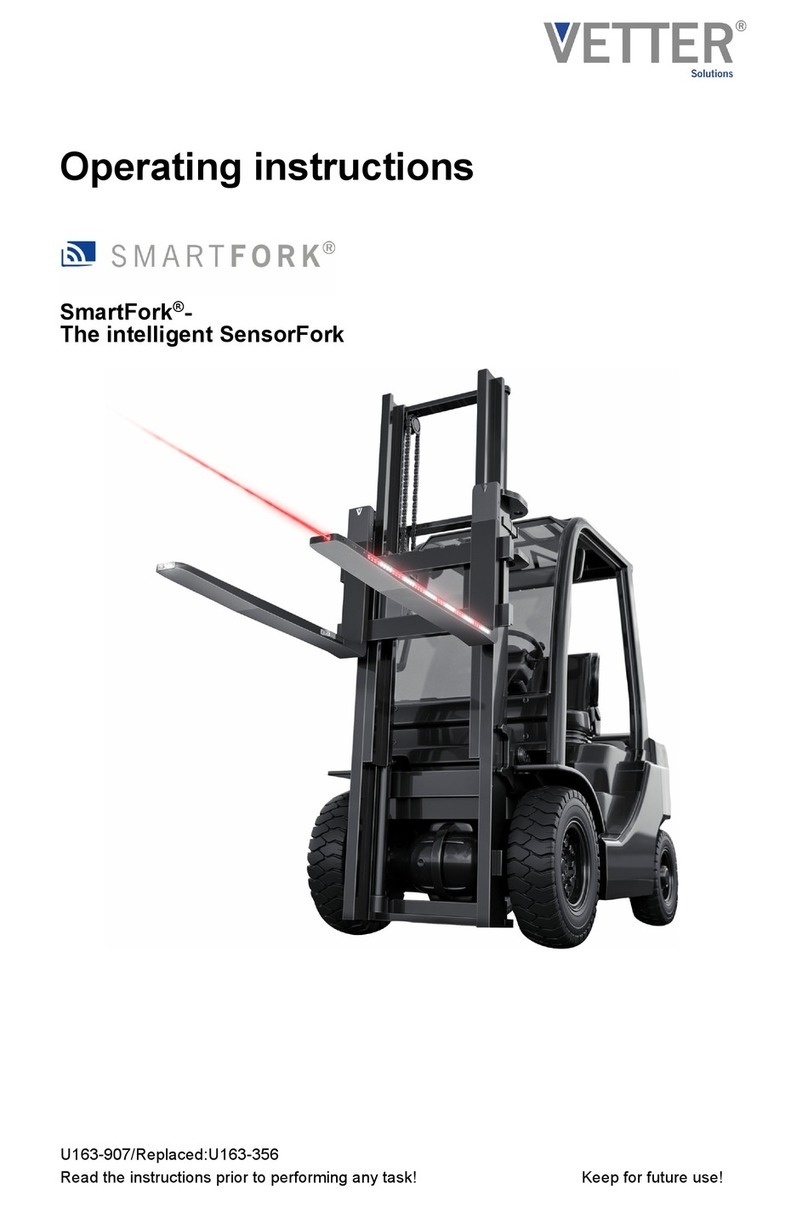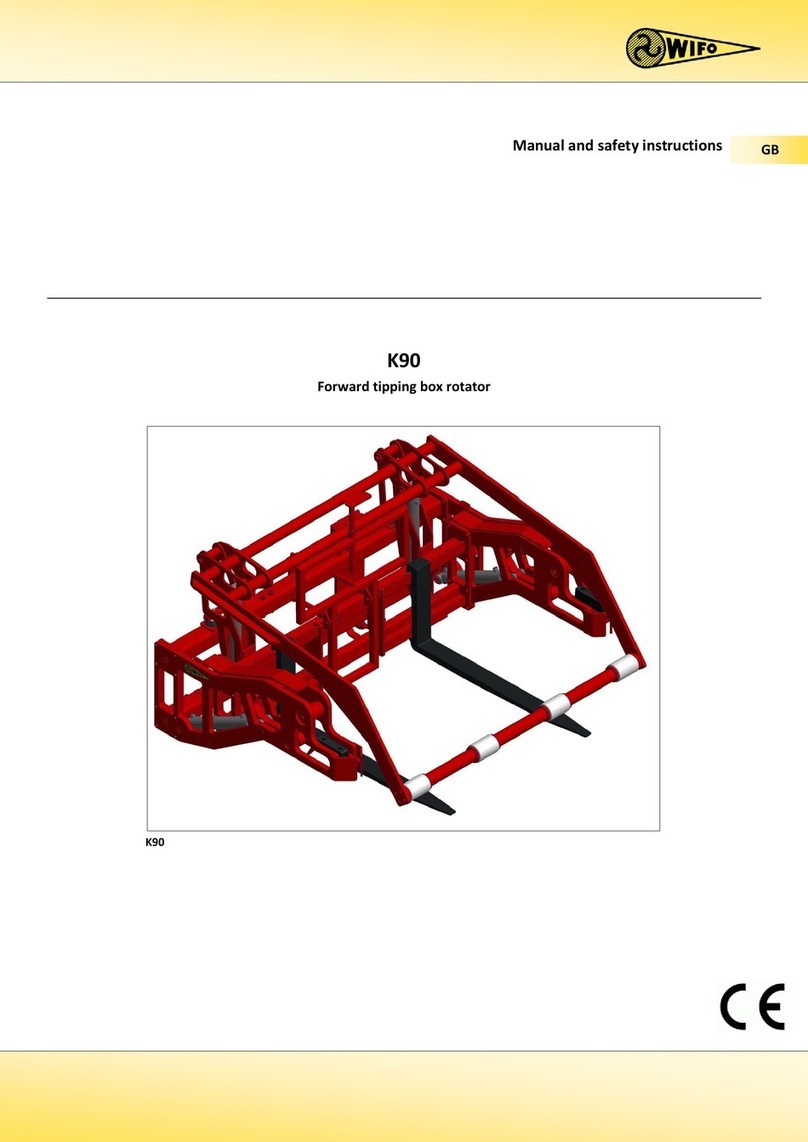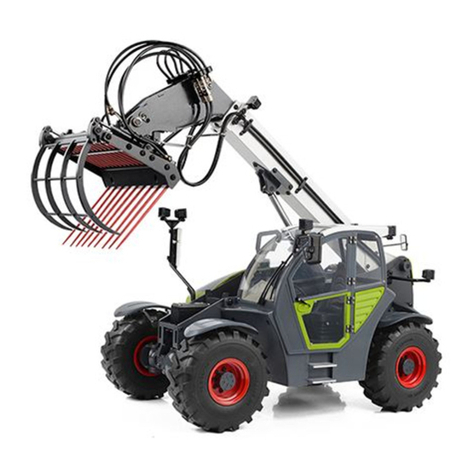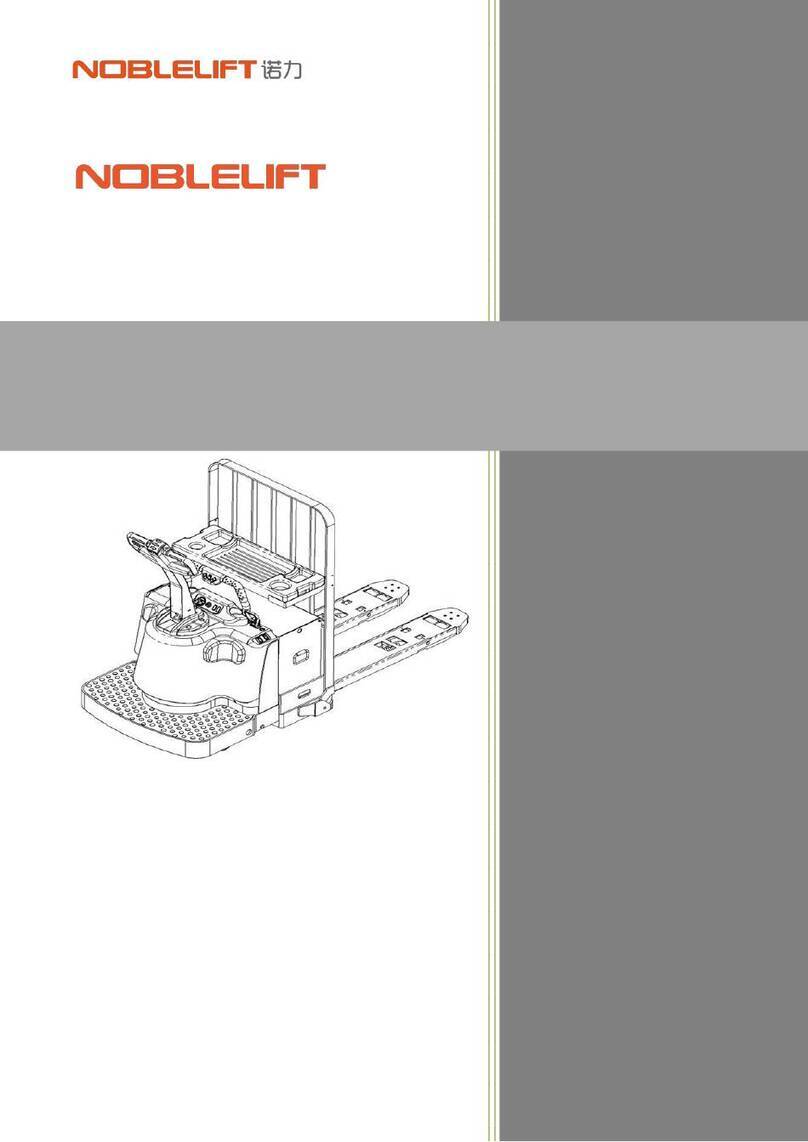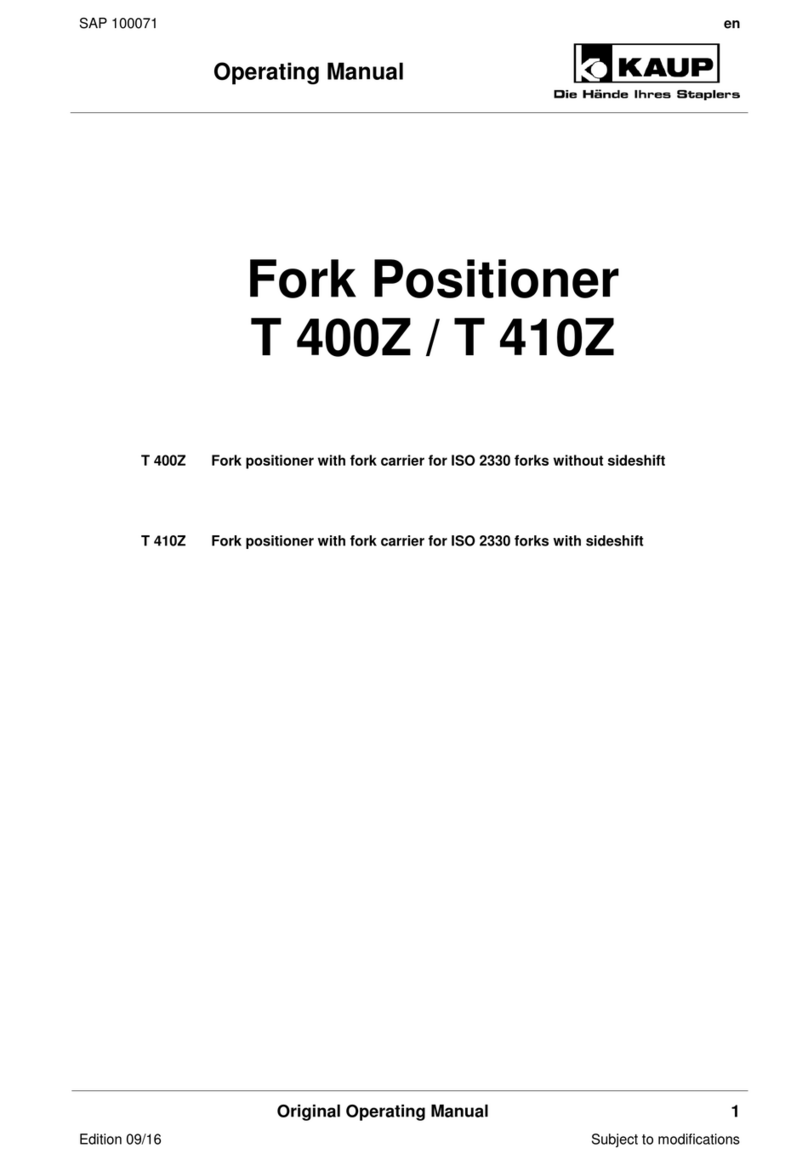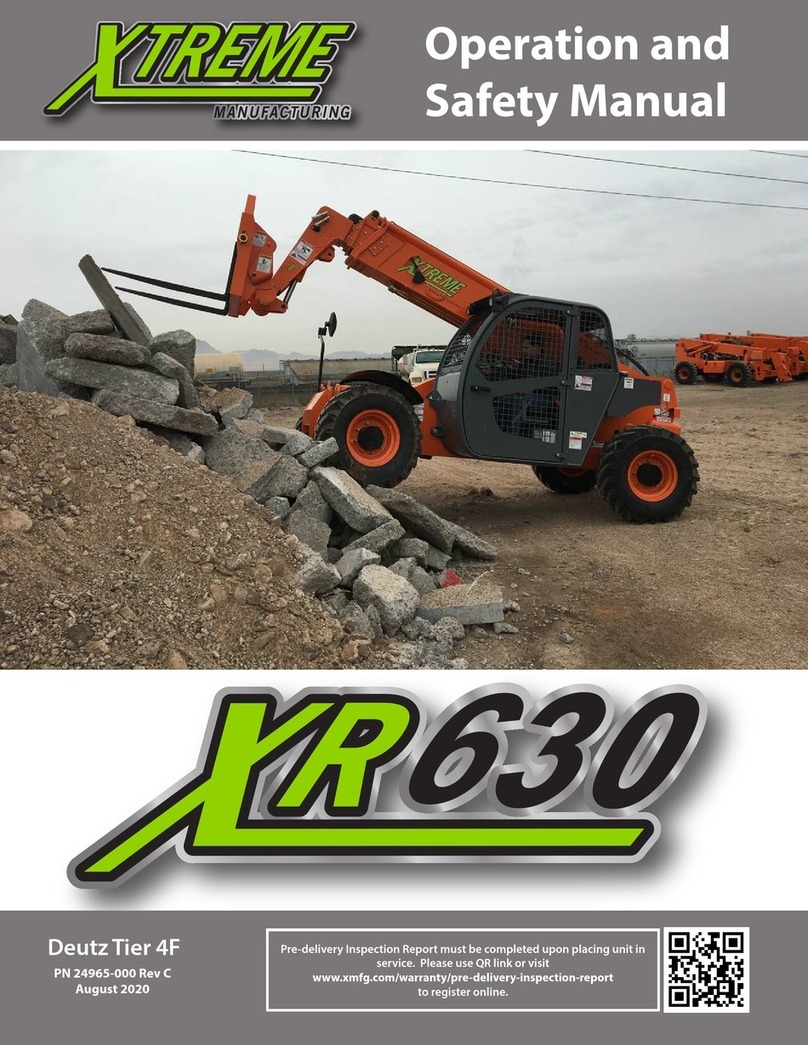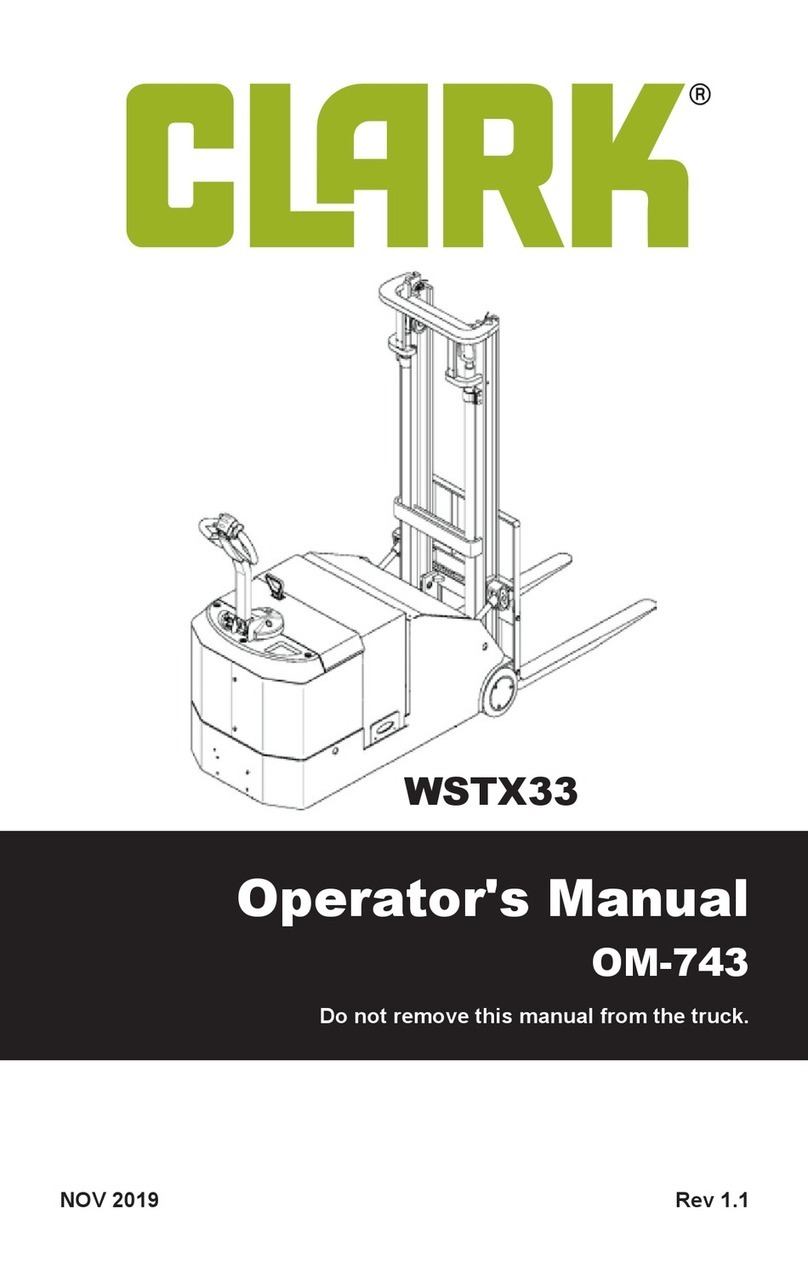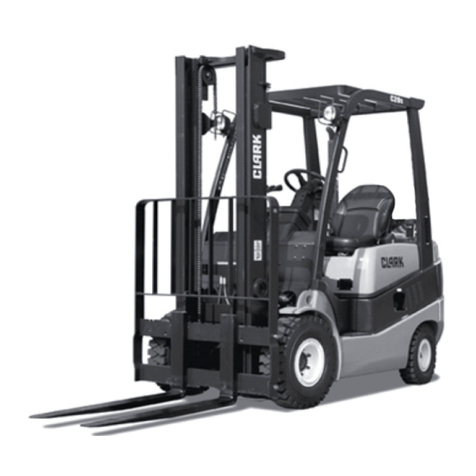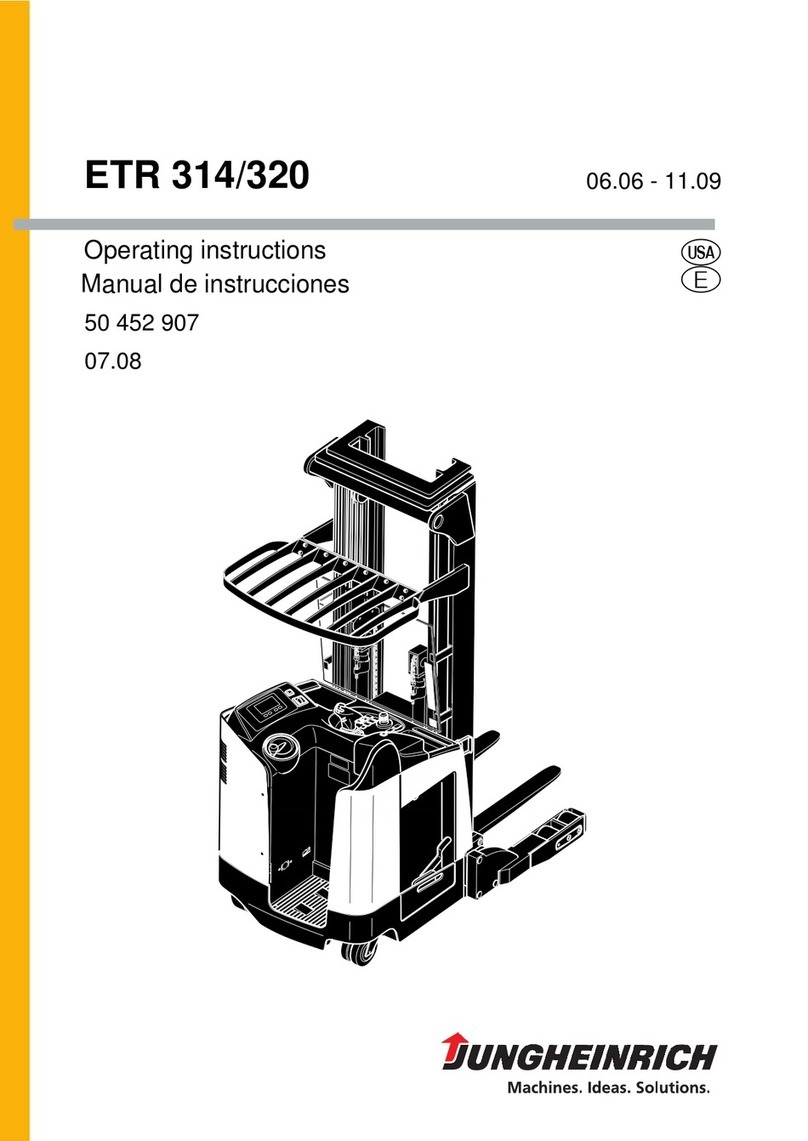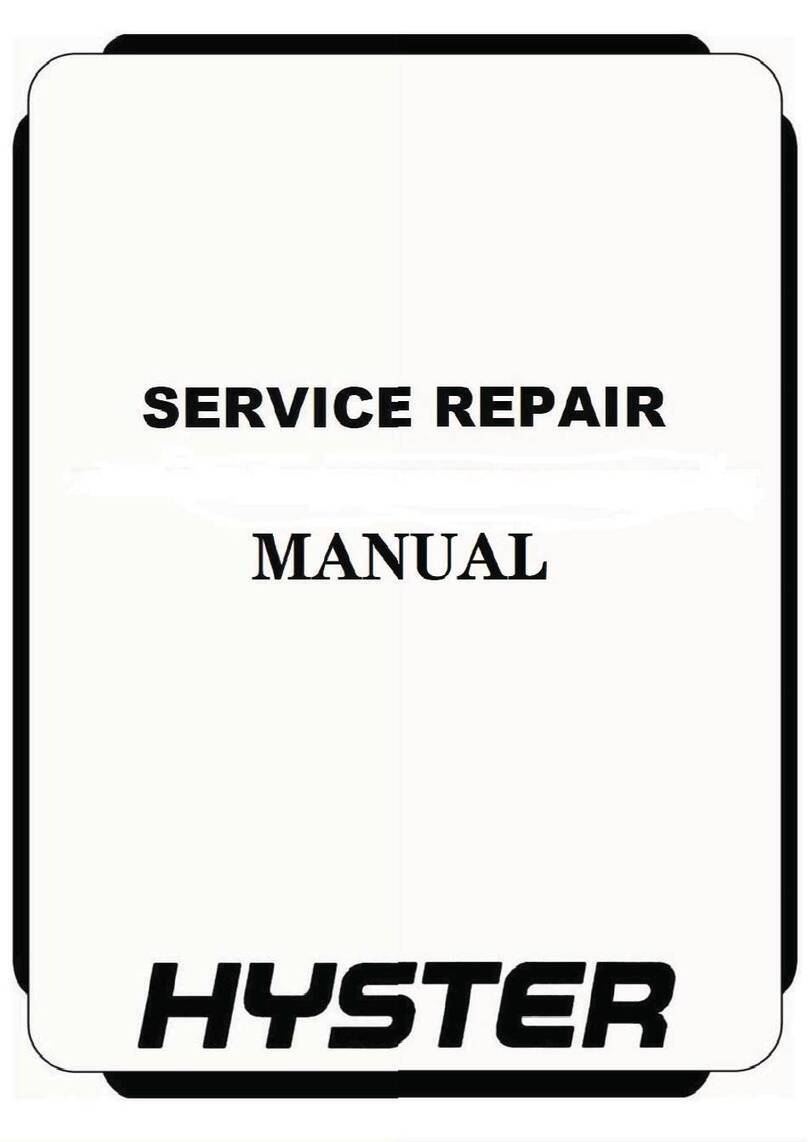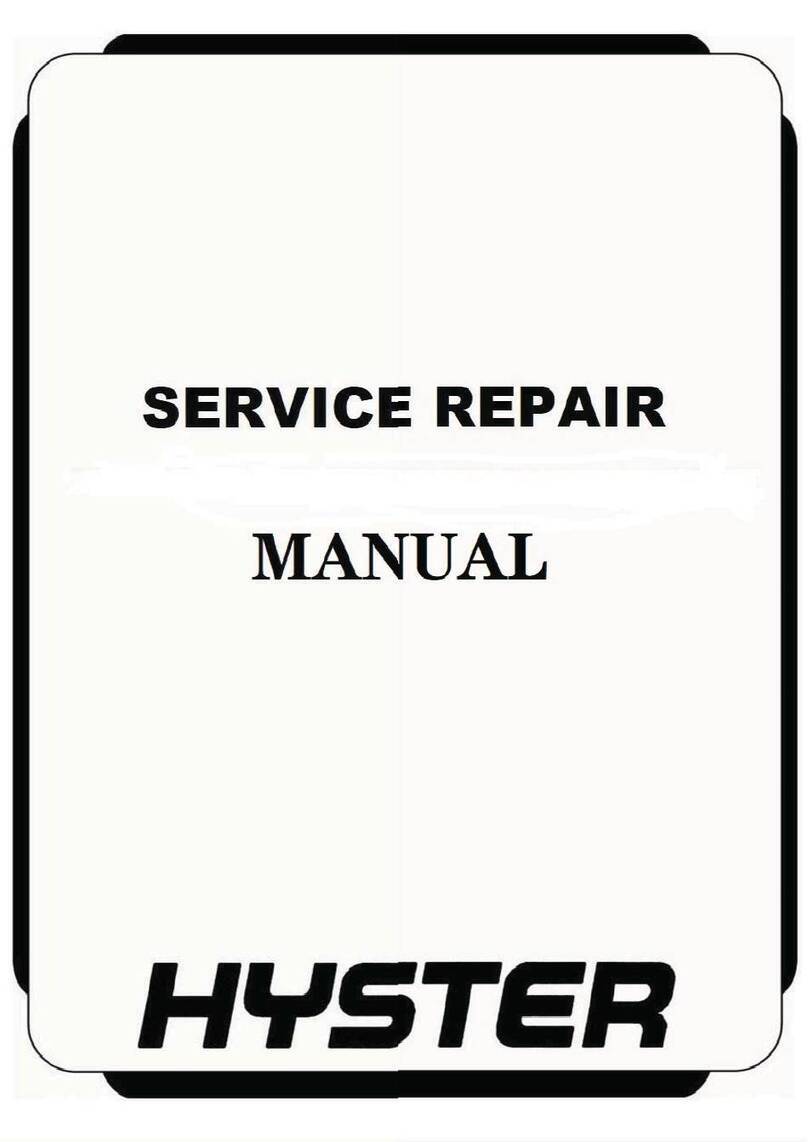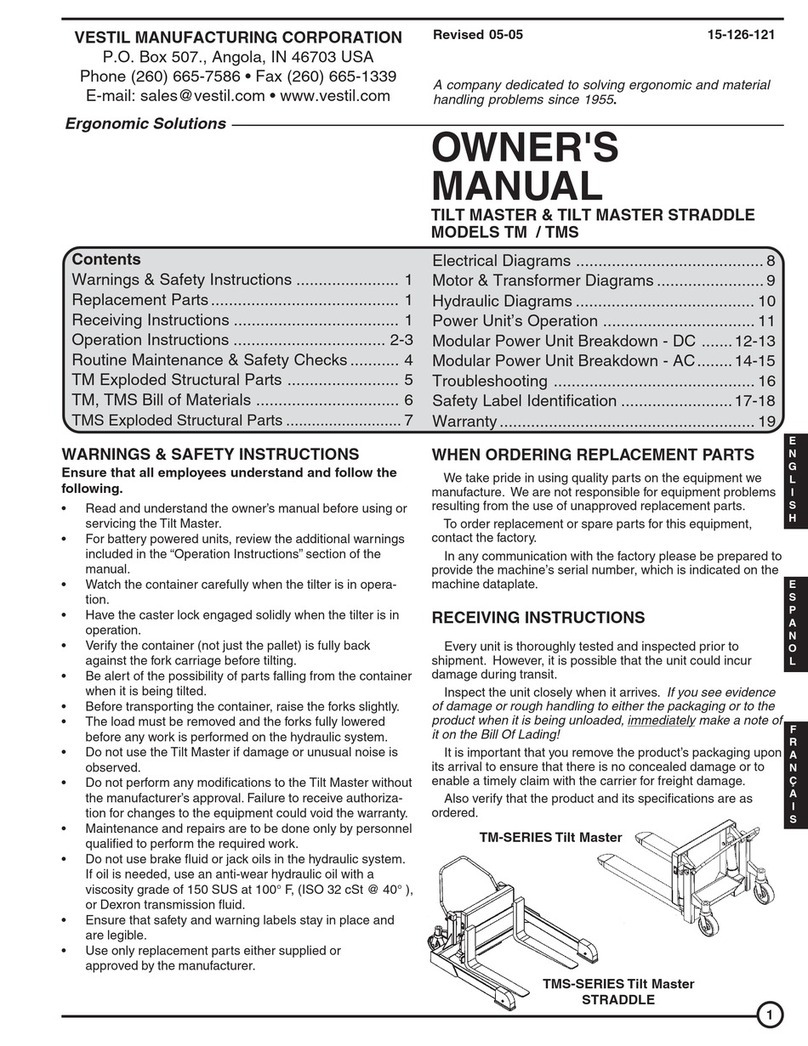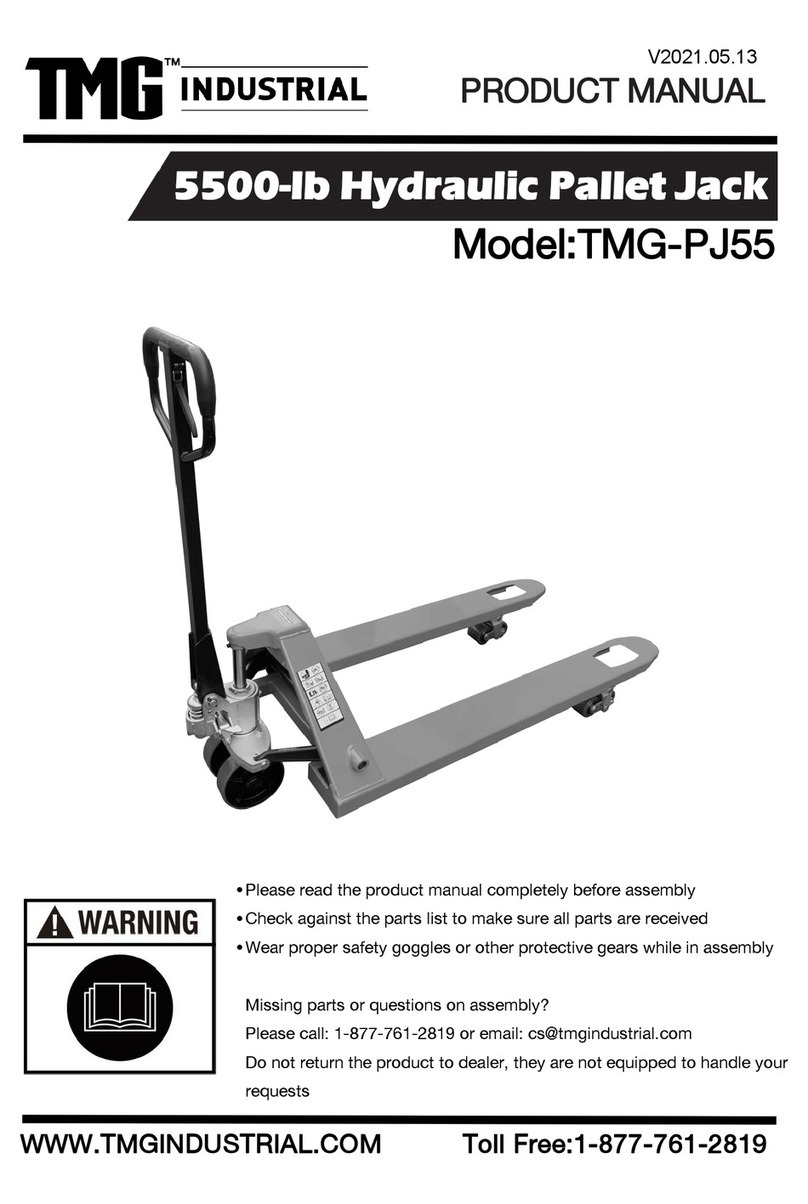Big Joe PPT 45 Series Use and care manual

PPT0104-901336 i
PPT 45 Series
Self-Propelled,
Pallet Lift Truck
Serial Numbers 373323
through 374781
Operation
Maintenance
Repair Parts List
Manual No. 901336

ii PPT0104-901336
SAFETY SECTION
SAFETY WARNINGS
Throughout this manual the following Warning Words
will be used in conjunction with important operator
instructions. The listing below shows the level of the
warnings.
DANGER
This is the highest level statement. Failure to follow the
listed instructions will most likely result in severe injury
or death.
WARNING
This is a statement of serious hazard. Failure to follow
the listed instructions could place the individual at risk
of serious injury or death. The statements used with
this level of warning deal with a safe operating
procedure. If the procedure is ignored, the possibility of
personal injury may exist.
CAUTION
The statements used with this level of warning deal
with a safe operating procedure. If the procedure is
ignored, the possibility of personal injury may exist.
IMPORTANT
This type of statement is used to draw attention to a
procedure that needs to be followed to prevent
machine damage.
Energy Isolation
During the servicing of the PPT 45 it may be required to
work with and around electrical power. In most cases,
the truck will be serviced with the batteries
disconnected. However, some of the service
procedures may require working with the battery
connected or within the battery charger. As required,
the lockout and tagout of the main power supply will be
required and will need to be indicated as shown below.
Lockout: The placement of a lockout device on an
energy-isolating device (breaker panel, etc.), in
accordance with an established procedure, ensur-
ing that the energy- isolating device and the equip-
ment being controlled cannot be operated until the
lockout device is removed.
Tagout: The placement of a tagout device on an
energy- isolating device (circuit breaker), in accor-
dance with an established procedure, to indicate
that the energy-isolating device and the equipment
being controlled cannot be operated until the
tagout device is removed.
An appropriate locked out and tagged out power supply
is shown in the illustration below. The tag, as
suggested by the illustration below, should accompany
lockout devices used for this safety function.
DANGER
WARNING
CAUTION
IMPORTANT

Table of Contents
PPT0104-901336 iii
SECTION 1 DESCRIPTION
1-1. INTRODUCTION .........................................................................................................................................1-1
1-2. GENERAL DESCRIPTION ..........................................................................................................................1-1
1-3. NAMEPLATE ...............................................................................................................................................1-1
1-4. SAFETY FEATURES...................................................................................................................................1-2
1-5. OPTIONS.....................................................................................................................................................1-2
SECTION 2 OPERATION
2-1. GENERAL....................................................................................................................................................2-1
2-2. OPERATING PRECAUTIONS ....................................................................................................................2-1
2-3. GENERAL CONTROL OPERATION ...........................................................................................................2-2
2-4. DRIVING AND STOPPING PROCEDURES ...............................................................................................2-2
2-4.1. Standard Travel ................................................................................................................................2-2
2-4.2. Creep Travel.....................................................................................................................................2-2
2-5. BELLY-BUTTON SWITCH. (Figure 2-1)......................................................................................................2-3
2-6. STEERING ARM RETURN SPRING...........................................................................................................2-3
2-7. LIFT AND LOWER CONTROLS..................................................................................................................2-3
2-8. LOADING AND UNLOADING......................................................................................................................2-3
2-9. PARKING.....................................................................................................................................................2-3
SECTION 3 MAINTENANCE
3-1. GENERAL....................................................................................................................................................3-1
3-2. OPERATOR DAILY CHECKS .....................................................................................................................3-1
3-3. MONTHLY AND QUARTERLY CHECKS....................................................................................................3-1
3-4. BATTERY CARE .........................................................................................................................................3-1
3-4.1. General.............................................................................................................................................3-1
3-4.2. Battery Removal ...............................................................................................................................3-3
3-4.3. Testing and Charging of Lead Acid Battery......................................................................................3-3
3-5. LUBRICATION.............................................................................................................................................3-4
SECTION 4 ADJUSTMENT AND REPAIR
4-1. GENERAL....................................................................................................................................................4-1
4-2. PART NUMBER IDENTIFICATION .............................................................................................................4-1
4-3. STEERING ARM AND CONTROL HEAD ...................................................................................................4-1
4-3.1. Belly-Button Switch Adjustment........................................................................................................4-1
4-3.2. Potentiometer Testing and Adjustment ............................................................................................4-2
4-3.3. Control Head Switch Replacement...................................................................................................4-3
4-3.4. Steering Arm.....................................................................................................................................4-4
4-3.5. Steering Arm Spring Replacement ...................................................................................................4-5
4-3.6. Electrical Control Cable Replacement..............................................................................................4-6
4-4. BRAKES ......................................................................................................................................................4-8
4-4.1. Brake Pad Adjustment......................................................................................................................4-8
4-4.2. Brake Pad Replacement...................................................................................................................4-9
4-4.3. Replacement of Brake Assembly ...................................................................................................4-11

iv PPT0104-901336
4-4.4. Replacement of Dead-Man Switch ................................................................................................. 4-12
4-4.5. Replacement of Creep Travel Switch ............................................................................................. 4-12
4-4.6. Replacement of Control Arm Shock Absorber................................................................................4-13
4-5. DRIVE MOTOR, TRANSMISSION, DRIVE WHEEL, AND PIVOT TUBE ASSEMBLY .............................4-13
4-5.1. Drive Motor Servicing. .................................................................................................................... 4-13
4-5.2. Inspect and replace worn brushes as follows:................................................................................4-13
4-5.3. Inspect commutator assembly........................................................................................................ 4-14
4-5.4. If the motor needs to be replaced, remove it from the transmission as follows:.............................4-15
4-5.5. Transmission Assembly Removal. ................................................................................................. 4-16
4-6. BASE, FRAME AND FORK SECTION ......................................................................................................4-17
4-6.1. General...........................................................................................................................................4-17
4-6.2. Load Wheel Replacement .............................................................................................................. 4-17
4-6.3. Frame Assembly: Fork Section and Lift Linkage Repair and Replacement. .................................. 4-18
4-7. ELECTRICAL.............................................................................................................................................4-20
4-7.1. Battery Removal and Replacement................................................................................................ 4-20
4-7.2. Battery Cable Assemblies Replacement. .......................................................................................4-20
4-7.3. Transistor/Contactor Panel............................................................................................................. 4-21
4-7.4. Horn Replacement..........................................................................................................................4-22
4-7.5. Battery Charger. ............................................................................................................................. 4-23
4-7.5.1. 12V Light Duty Gel-Cell Batteries .................................................................................4-23
4-7.5.2. Medium Duty 6V Battery Pack...................................................................................... 4-23
4-7.5.3. Heavy Duty 24V Steel Case Flooded Cell Industrial Battery (Not shown)....................4-23
4-7.6. BATTERY DISCHARGE INDICATOR............................................................................................4-24
4-7.6.1. Battery Discharge Indicator Replacement. ................................................................... 4-24
4-7.7. HOURMETER. ...............................................................................................................................4-25
4-7.7.1. Hour meter Replacement. ............................................................................................4-25
4-7.8. KEYSWITCH. .................................................................................................................................4-25
4-7.9. Wire Harness Testing. ....................................................................................................................4-25
4-8. HYDRAULICS............................................................................................................................................ 4-27
4-8.1. Line and Fitting Replacement.........................................................................................................4-27
4-8.2. Hydraulic Pump, Motor, and Reservoir Assembly. ......................................................................... 4-27
4-8.3. Lift Cylinder Removal. .................................................................................................................... 4-29
4-8.4. Lift Cylinder Repair. ........................................................................................................................ 4-29
4-8.5. Hydraulic Pressure Adjustment. .....................................................................................................4-30
4-9. DECALS AND TRIM. .................................................................................................................................4-30
4-9.1. Painting Requirements. ..................................................................................................................4-30
4-9.2. Decals and Plates. .........................................................................................................................4-30
SECTION 5 OPTIONS
5-1. COLD CONDITIONING PACKAGE............................................................................................................. 5-1

PPT0104-901336 v
SECTION 6 TROUBLESHOOTING
6-1. TROUBLESHOOTING CHART ...................................................................................................................6-1
6-2. Contactor Testing ........................................................................................................................................6-3
6-2.1. Contactor Testing .............................................................................................................................6-3
6-2.2. Switch Testing. .................................................................................................................................6-3
6-3. TRANSISTOR CONTROLLER TROUBLESHOOTING ............................................................................... 6-5
6-3.1. Circuit Operation...............................................................................................................................6-6
6-3.2. GENERAL SYSTEM CHECKOUT. ..................................................................................................6-9
6-3.3. ADJUSTMENT ...............................................................................................................................6-10
6-4. DIAGNOSTICS. .........................................................................................................................................6-11
6-4.1. Programmer Diagnostics ................................................................................................................6-12
6-4.2. Diagnostic History...........................................................................................................................6-12
6-4.3. Test the Fault Detection Circuitry ...................................................................................................6-12
6-5. Maintenance ..............................................................................................................................................6-12
6-5.1. Cleaning .........................................................................................................................................6-13
6-5.2. Transistor Control Electrical Panel Maintenance............................................................................6-13
6-6. Troubleshooting .........................................................................................................................................6-13
6-6.1. Check for Power to the Controller ..................................................................................................6-14
6-6.2. Check for Contactor Operation and Keyswitch Input (KSI) ............................................................6-14
6-6.3. Check Potentiometer Circuitry........................................................................................................6-14
6-6.4. Check for controller output .............................................................................................................6-15
SECTION 7 PARTS LIST
7-1. Control Head Assembly ...............................................................................................................................7-2
7-2. Steering Arm ................................................................................................................................................7-6
7-3. Power Section Parts ....................................................................................................................................7-8
7-4. Transmission, Motor and Brake Assembly ................................................................................................7-12
7-5. Drive Motor Repair Parts ...........................................................................................................................7-14
7-6. Base and Frame Parts ...............................................................................................................................7-17
7-7. Fork Section Parts .....................................................................................................................................7-18
7-8. Hydraulic Cylinder Parts ............................................................................................................................7-21
7-9. Hydraulic Cylinder Parts ............................................................................................................................7-22
7-10. Battery Installation Parts ............................................................................................................................7-24
7-11. Battery Charger Assembly.........................................................................................................................7-26
7-12. Contactor Panel Assembly Parts ...............................................................................................................7-28
7-13. Charger Circuit Board ................................................................................................................................7-30
7-14. Load Wheels..............................................................................................................................................7-31
7-15. Optional Equipment ...................................................................................................................................7-32
7-15.1.Cold Conditioning ...........................................................................................................................7-32

vi PPT0104-901336

PPT0104-901336 1-1
Section 1
DESCRIPTION
1-1. INTRODUCTION
This publication describes the PPT 45 lift truck
manufactured by Big Joe Manufacturing Company,
Lincolnwood, Illinois 60646. Covered in this manual are
operating instructions, planned maintenance
instructions, lubrication procedures, corrective
maintenance procedures and a complete parts list with
parts location illustrations.
By following the recommendations contained in this
manual, you will receive many years of dependable
service from your Big Joe lift truck.
1-2. GENERAL DESCRIPTION
The self-propelled PPT 45 truck, Figure 1-1, lifts and
transports payloads up to 4500 pounds on rigid forks.
The forward and reverse motion is controlled by either
of two control levers mounted on the control head.
Stopping and turning is controlled by the steering arm.
Lift and Lower is controlled by pushbuttons located on
the control head. The battery-powered lift truck is quiet
and without exhaust fumes.
The reversible DC motor propels the lift truck in forward
or reverse direction throughout the available speed
range. The PPT 45 lift truck can be driven with forks
raised or lowered. The lift truck must be operated and
stored in an area where it will be protected from the
elements.
1-3. NAMEPLATE
The nameplate (Figure 1-2) is the key for identifying
many of the features of your lift truck. It provides
information such as:
• Model number
• Serial number
• Maximum capacity, load center, and maximum
lift height
• If applicable, alternate capacity, load center,
and maximum lift height
• Truck weight without battery
• Minimum weight of battery
• Battery voltage
Refer to Figure 1-1 for serial number location, if the
nameplate becomes lost or illegible.
Figure 1-1. PPT 45 Orientation
Logo Plate
And Insert
Operationing
Instructions
Big Joe Logo Big Joe Logo
Name
Plate
Access Panel
Caution Decal
3 places
No Rider
Decal
S/N Location
I-7001

1-2 PPT0104-901336
1-4. SAFETY FEATURES
The PPT 45 is designed and engineered to provide
maximum safety for operator and payload. Some of the
safety features incorporated into the design are:
• Deadman brake to apply mechanical brake and cut
off drive power when the steering arm is released.
• Belly-button switch to reverse truck should the
operator accidentally pin himself against a wall or
obstruction when backing up in slow speed.
• All control functions automatically return to 'OFF"
when released.
• Externally accessible quick-disconnect battery plug
within operator's reach.
• Separately fused control circuits and power cir-
cuits.
• Lift carriage backrest to help stabilize the load.
• Readily accessible HORN button.
• Slip-resistant hand grips to provide a firm hand
hold for operator.
• Flow control valve regulates maximum load lower-
ing speed within prescribed limits.
• Relief valve maintains hydraulic pressure within
prescribed limits.
• High visibility color scheme of truck provides visual
alert of trucks presence.
1-5. OPTIONS
Big Joe offers options and accessories for the PPW 45
lift truck such as:
• Cold conditioning package
• Load backrest extension
• Skid adapter
•Casters
Figure 1-2. Name Plate
SERIAL NO.
MAX CAP LB/KG LOAD CTR IN/NM LIFT HT IN/MM
MAX CAP LB/KG
TRUCK WT LESS BATTERY LB/KG.
BATTERY MIN WT LB/KG
LOAD CTR IN/NM LIFT HT IN/MM
TRUCK WT WITH BATTERY LB/KG.
BATTERY MAX WT LB/KG
MODEL NO
TRUCK
TYPE
BATTERY
TYPE
CERTIFIED TRUCK
TYPE
COMPLIES WITH THE APPLICABLE REQUIRE-
MENTS OF ANSI B56.1 AND OSHA STANDARDS
US PATENT NO. 4,444,428
AUSTRALIAN PATENT NO. 537,987
BIG JOE MANUFACTURING COMPANY
WISCONSIN DELLS, WISCONSIN 53965
I-7002

PPT0104-901336 2-1
Section 2
OPERATION
2-1. GENERAL
This section gives detailed operating instructions for
the PPT 45 lift truck. The instructions are divided into
the various phases of operations, such as operating lift,
driving, and stopping. Routine precautions are included
for safe operation.
2-2. OPERATING PRECAUTIONS
1. Do not operate this truck unless you have been
trained and authorized to do so and have read all
warnings and instructions in this manual and on the
truck.
2. Do not operate this truck until you have checked its
condition. Give special attention to Tires and
Rollers, Horn, Battery, Controller, Lift System,
Brakes, Steering Mechanism, Guards and Safety
Devices.
3. Operate truck only from designated operation
position. Wear foot protection. Do not carry
passengers.
4. Observe applicable traffic regulations. Yield right of
way to pedestrians. Slow down and sound horn at
cross aisles and wherever vision is obstructed.
5. Start, stop, travel, steer and brake smoothly. Slow
down for turns and on uneven or slippery surfaces
that could cause truck to slide or overturn. Use
special care when traveling without load, as the
risk of overturn may be greater.
6. Always look in direction of travel. Keep a clear
view, and when load interferes with visibility, travel
with load or lifting mechanism trailing.
7. Use special care when operating on ramps-travel
slowly, and do not angle or turn. Travel with lifting
mechanism or load downhill.
8. Do not overload truck. Check nameplate for
capacity and load center information.
9. Before lifting, be sure load is centered, forks are
completely under load, and load is as far back as
possible against load backrest.
10. Do not handle loads that are higher than the load
backrest unless load is secured so that no part of it
could fall backward.
11. When leaving truck, neutralize travel control. Fully
lower lifting mechanism and set brake. When
leaving truck unattended or storing for prolonged
periods, disconnect battery.
Figure 2-1. Steering Control
Improper operation of the lift truck may result in
operator injury, or load and/or lift truck damage.
Observe the following precautions when
operating the PPT 45 lift truck.
WARNING
Steering
Arm
High Speed
CutOu t Switch
Reverse
Speed
Control
Forward
Speed
Control
Fork
Lower
Control
Fork
Raise
Control
Horn
Pushbutton
Belly Button
Switch Guard
If Rotating Grips
Are Preferred,
Remove Pins
I 7003
I-7003

2-2 PPT0104-901336
2-3. GENERAL CONTROL OPERATION
The speed control (Figure 2-1), located on each side of
the control head, provides fingertip control for driving
the truck. Rotating, or pressing the speed control
downwards moves the truck in the FORWARD
direction. As the speed control is pressed, it closes
electrical contacts for first speed, or creep, in the
forward direction. Pressing the speed control farther
increases the speed of the truck. The speed control is
infinitely variable, which means that the farther the
control is pressed, the faster the truck will move.
NOTE: The truck is equipped with a High Speed
Cutout Switch, located on the control head,
higher travel speeds will be available. With this
switch in the OFF position, standard travels
speeds are available. Place the switch in the
ON position to enable the highest travel
speed.
Rotating or pressing the speed control upwards moves
the truck in the REVERSE direction. The upper portion
of the speed control controls the reverse speeds in the
same manner.
The pushbutton switches, located behind the belly
button switch guard, activate the lift-lower controls and
the horn.
The brake is applied by lowering or raising the steering
arm. When the steering arm is lowered or raised
approximately half way the brakes are partially applied.
When the steering arm is raised completely vertical,
the brakes are fully applied. (See Figure 2-2) All
traction control power is shut off when the brake is
engaged. When the steering arm is in the upright
position, the brake acts as a parking brake. Deadman
braking occurs when the handle is released and spring
action raises it to the upright position.
2-4. DRIVING AND STOPPING PROCEDURES
2-4.1 Standard Travel
1. If equipped, turn on the key switch. Grasp the grips
of the steering arm so that the speed control can
be comfortably operated by either thumb.
2. Lower the steering arm to a comfortable position
above horizontal to disengage the brake and to
energize the electrical circuits.
3. To move forward (with load trailing), slowly press
the speed control downwards. Press the forward
speed control farther to increase speed. If
engaged, the High Speed cutout switch will disable
the highest travel speeds.
4. To slow down or stop, release the speed control
and lower or raise the steering arm to the
horizontal or vertical position. In those positions,
the brake pads apply pressure to the brake disc
slowing or stopping the truck.
NOTE: Procedures for movement in reverse are
the same as in the forward direction.
5. To travel in reverse, lower steering arm to a
comfortable position above horizontal and slowly
press the speed control upwards.
2-4.2 Creep Travel
1. Creep, or the slowest travel speed, is available in
both forward and reverse.
2. Lower the handle from the vertical position until
you hear a "click" which indicates that the controls
are energized. See Figure 2-2.
3. Rotate the speed control for either forward or
reverse travel.
Figure 2-2. Brake Arm Actuation
With the control handle in the creep position, creep
speed will be the only speed available no matter how
far the speed control is rotated.
IMPORTANT
Brake Fully Engaged
Controls De-energized
Brake Dis-engaged,
Forward/Reverse
Creep Speed Enabled,
All Controls Energized
Brake Dis-engaged,
All Controls Energized
Brake Fully Engaged
Controls De-energized
I-7004

PPT0104-901336 2-3
2-5. BELLY-BUTTON SWITCH. (FIGURE 2-1)
The belly-button switch (Figure 2-1) minimizes the
possibility of the driver being pinned by the steering
arm while driving the lift truck forward in slow speed. If
the guard presses against the operator while the lift
truck is being driven forward, the guard actuates a
switch, which changes the direction of the lift truck to
reverse direction in low speed.
2-6. STEERING ARM RETURN SPRING
The steering arm return spring automatically raises the
steering arm to the upright position when the steering
arm is released. If the steering arm snaps up abruptly,
or does not fully raise, the steering arm return spring
requires adjustment. Return truck to maintenance for
adjustment.
2-7. LIFT AND LOWER CONTROLS
Lift/Lower Control buttons are located on the steering
control head, behind the belly button switch guard.
(Figure 2-1)
• To lift the forks, push in LIFT button and hold until
forks reach desired height.
• To lower the forks, push in LOWER button and
hold until forks descend to desired height.
2-8. LOADING AND UNLOADING
1. Move truck to location where load is to be picked
up.
2. Using the BACKWARD speed control, move truck
backward into position so forks are within pallet or
skid, the load is centered over the forks and as far
back toward the backrest as possible.
3. Raise forks to lift load.
4. Drive to area where load is to be placed.
5. Move truck to position load at the delivery location.
6. Lower the load until it rests squarely in place and
the forks are free.
7. Using the FORWARD speed control, slowly move
the truck straight forward to remove forks from
pallet.
2-9. PARKING
When finished with moving loads, drive truck to its
maintenance or storage area. If equipped, turn off the
key switch. If the lift truck is designed to use a remote
charger, disconnect battery cable from the truck
receptacle and connect it to the chargers receptacle. If
the lift truck is equipped with an internal charger,
connect the power cable to the charger plug to charge
the batteries.
Charge batteries as necessary. Refer to battery care
instructions, Section 3-4.

2-4 PPT0104-901336
NOTES:

PPT0104-901336 3-1
Section 3
MAINTENANCE
3-1. GENERAL
Maintenance includes both the operator daily check
procedures and scheduled maintenance, which must
be performed by a qualified service technician. Any
problems noted during the operator's daily inspection
or the monthly and quarterly scheduled maintenance
procedures must be corrected by a qualified
maintenance technician.
3-2. OPERATOR DAILY CHECKS
Table 3-1 is a checklist identifying both visual and
operational checks that must be performed by the
operator on a daily basis to ensure the safety of the
equipment. Optional items are noted as such.
3-3. MONTHLY AND QUARTERLY CHECKS
Table 3-2 is a monthly and quarterly inspection and
service chart based on normal usage of equipment.
Normal use is eight hours per day, five days per week
for a total of 40 hours per working week. If the lift truck
is used in excess of forty hours per week, the
frequency of inspection and service should be
increased accordingly.
3-4. BATTERY CARE
3-4.1 General
The life of the batteries can be extended by giving them
proper care. Perform a daily check of the batteries
whether or not the equipment is in daily use.
• If the truck is found to be in need of repair,
unsafe, or contributes to an unsafe
condition, report it immediately to your
designated authority.
• If during operation, the truck becomes
unsafe, report it immediately.
• Do not operate the truck until it has been
restored to safe operating condition.
• Do not make any unauthorized repairs or
adjustments.
WARNING
• Hydrogen gas that vents from lead acid
batteries can explode. Do not smoke, use an
open flame, or create an arc or sparks in the
vicinity of the batteries. Ventilate well when
in an enclosed space and when charging.
• The batteries contain SULFURIC ACID, which
causes severe burns. Do not get acid in eyes,
on the skin or clothing. In case of contact,
flush immediately and thoroughly with clean
water. Obtain medical attention when eyes
are affected.
• DO NOT overcharge the batteries or battery life
will be shortened.
• DO NOT allow batteries to become completely
discharged (specific gravity 1.150 or less for
flooded cell batteries. Maintenance free battery
charge level is not measured by specific gravity).
This will also greatly shorten battery life.
WARNING
IMPORTANT

3-2 PPT0104-901336
Table 3-1. Daily Checks
VISUAL CHECKS
ITEM PROCEDURE
DAMAGE Check for bent, dented or broken parts.
LEAKS Check drive unit and hydraulic system.
TIRES AND WHEELS Check drive wheel and load wheels for wear, damage, binding, etc.
FORKS Check for bends and misalignment.
CABLES AND HOSES Check that they are in place and not damaged.
BATTERY If your unit is equipped with flood cell batteries, check the water level and vent
caps for damage or plugging.
IMPORTANT: If the lift truck is equipped with maintenance free batteries, DO
NOT attempt to remove battery caps.
BATTERY CONNECTOR Check for cracks, burns and for tight connections with truck receptacle.
GUARDS Check load backrest, covers and guards for damage.
SAFETY DEVICES Check that warning labels, data plates, etc. are in the same condition as
originally equipped.
FRAME AND SERVICE
COVER
Check for damaged paint, cracks in welds or other damage.
OPERATIONAL CHECKS
HORN Check for sound.
STEERING Check for binding or excessive play. Excessive play will be indicated by a
physical shifting or movement of the transmission.
TRAVEL Check all speed ranges, forward and reverse. No unusual noise should be
present.
HYDRAULIC CONTROLS Check lift and lower for binding or unusual noises, etc.
BRAKES Check that brake stops truck within a safe distance and works smoothly. Check
dead-man brake by releasing handle.
HOUR METER Check for proper operation.
PARKING BRAKE Make sure it holds the truck in place.
BATTERY CHARGE
INDICATOR
Check that battery discharge indicator is on "full" or the specific gravity of
batteries, as checked with a hydrometer, indicates full charge.
BELLY BUTTON SWITCH In an open and unrestricted area check for proper operation.

PPT0104-901336 3-3
Table 3-2. Monthly and Quarterly Inspection and Service Chart
NOTE: The following service checks should be performed by a qualified service technician.
3-4.2 Battery Removal
The PPT 45 has three optional battery sets, a single
industrial battery, a set of two 12 V batteries or a set of
four 6V batteries.
Each of the battery sets is enclosed in a removable
case. Removal of battery requires that the electrical
cables to the lift truck be disconnected. When the
cables have been disconnected, the batteries or
battery case can be removed from the lift truck.
(Section 4-7).
3-4.3 Testing and Charging of Lead Acid Bat-
tery
Use the following procedure for flooded cell batteries:
NOTE: If the lift truck is equipped with maintenance
free batteries, skip steps 1 and 2. DO NOT
attempt to open maintenance free battery
caps.
1. Obtain a battery hydrometer.
2. Use the hydrometer to check specific gravity of
each cell.
NOTE: Battery specific gravity readings should
agree within ±0.025 from cell to cell. If
variation is greater, the battery may have
to be replaced.
INTERVAL INSPECTION OR SERVICE
Monthly Clean drive motor and check condition of commutator, brushes, and springs (Section 4-5).
Monthly Clean hydraulic pump motor and check condition of commutator, brushes, and springs
(Section 4-8).
Monthly Check brake for proper operation.
Monthly Check load wheels for wear. A poly load wheel must be replaced if worn to within 1/16 inch
of hub. Check for separation from hub.
Monthly Check drive wheel for wear. A poly drive wheel must be replaced if wheel is worn to within 1
inch of hub. Check for separation from hub.
Monthly Inspect wiring for loose connections and damaged insulation.
Monthly Inspect contactor for proper operation.
Monthly Check deadman brake switch for proper operation.
Quarterly Check lift cylinder for leakage.
Quarterly Check for excessive jerking of steering arm when stopping or starting.
Quarterly Check brake pads for wear. Brake pads must be replaced when air gap can not be
adjusted to tolerances shown in Section 4-4 Brakes.
The battery cases are heavy and can contain
flooded cell batteries. Use appropriate lifting
devices to remove the battery case from the lift
truck.
CAUTION
Be sure that no cell plates are exposed (not covered
by fluid) before charging. Add distilled water
sufficient to just cover top of cell plates. DO NOT
over fill cells.
Use distilled water only. Impurities in tap water will
damage battery plates.
IMPORTANT

3-4 PPT0104-901336
3. Charge batteries in accordance with hydrometer
readings.
NOTE: A fully charged battery has a specific
gravity of 1.260 to 1.275.
4. After charging, again check water level in each cell
of the flooded cell batteries. Water level must cover
plates but not be higher than the base of the
battery cell filler neck.
3-5. LUBRICATION
Refer to Table 3-3 for recommended types of grease
and oil. Table 3-3, in conjunction with Figure 3-1,
identifies the items requiring periodic lubrication and
where they are located on the lift truck.
Table 3-3. Recommended Lubricants
(See Table 3-4 for Application)
Figure 3-1. Lubrication Locations
• Do not service batteries while they are being
charged.
• Do not connect or disconnect battery from
charger while charger is on.
No. 1 Transmission oil - EP SAE 80W-go.
Capacity - 1.5 quart. Big Joe No. 055780
(Replace with 055790. 1W-30, if cold
conditioning option for continuous
operation below 320F is installed).
No. 2 Grease-Lithium base, general purpose. Big
Joe No. 055750 (Replace with 055753 if
cold conditioning option for continuous
operation below 320F is installed).
No. 3 Hydraulic oil. Big Joe No. 900855 (Gallon)
or 900893 (Quart). (Replace with 055784 if
cold conditioning option for continuous
operation below 320F is installed)
No. 4 Engine lubricating oil - No. 20
WARNING
I-7044

PPT0104-901336 3-5
Table 3-4. Lubrication Chart
*Raise lift truck to gain access to load wheels grease zerk. Illustration above shows only one side of the lift truck.
Repeat procedure on the other side of the truck.
Time Interval Figure 3-1
Index Location Method Of
Application
Type
(Table 3-4) Application of Lubricant
Semi-Annually
Steering Arm
Elbow
Oil Can No. 4 1 or 2 drops each time serviced
Annually 2Transmission
Housing
Can No. 1 Fill to plug level
Semi-Annually 1Hydraulic
Reservoir
Can No. 3 Lower carriage, fill to 1 inch
below elbow tap in reservoir
40 hours
Lift Linkage,
includes load
wheels*
Grease Gun No. 2 Pump until you see old grease
leave bushing
Semi-Annually
Drive unit
turntable
bearings
Grease Gun No. 2 5 or 6 pumps into each of two
bearing grease fittings.

3-6 PPT0104-901336
NOTES:

PPT0104-901336 4-1
Section 4
ADJUSTMENT AND REPAIR
4-1. GENERAL
This section contains information and procedures for
maintenance of the PPT 45 lift trucks. Maintenance
includes adjustment, and repair.
The illustrations in this section identify lift truck
maintenance parts. The callouts on each illustration
correspond to the reference index numbers in the
applicable text.
Parts listings are provided in Section 7 of this manual.
The parts list provides the Big Joe Manufacturing
Company part number, the part description, and the
quantity of the part required in the assembly.
When identifying each part to be ordered, visually
compare the part in the illustration with the actual part
needed. To assure proper identification of each part
being ordered, include your truck model number and
serial number (see nameplate), the part number
description and quantity of the part(s) needed. If the
nameplate becomes lost or illegible, refer to Figure 1-1
for other serial number locations.
4-2. PART NUMBER IDENTIFICATION
To determine the part number of a replacement part,
identify the assembly in which the part is used and in
Section 7, locate the illustration of the appropriate
assembly. Find the index number for the part on the
illustration and refer to that index number in the parts
list. If the part number is NP, order the next higher
assembly. If the part number is VAR, order by part
name with truck model number and serial number
If the part is listed with more than one part number,
select the proper part number by comparing the
description in the parts list with the specifications of
your truck. Refer to the nameplate to determine
application to your truck.
4-3. STEERING ARM AND CONTROL HEAD
WARNING: Testing of belly-button safety switches in
operation should be limited to areas clear of obstacles
against which an operator could be pinned. Use low
speed in forward.
4-3.1 Belly-Button Switch Adjustment.
If the actuator gap of the belly-button switch needs
adjustment, proceed as follows (Figure 4-1):
1. Disconnect the battery.
2. Drive out the roll pins that secure the belly-button
casting (Figure 4-1). Drive from the left to the right.
NOTE: While removing the belly-button casting,
the two return springs will drop free. Catch
the springs while pulling the casting away
to prevent their loss.
3. Bend actuator levers of belly-button switches to
adjust the gap between rollers and belly-button
casting as required (See Figure 4-1).
Figure 4-1. Steering Arm Control Head
If too small a gap exists between bellybutton switch
actuator rollers and the belly-button casting, one or
both of the belly-button switches may be actuated
constantly.
IMPORTANT
Belly Button
Springs
Belly Button
Casting
Gap
Roller
Bend Actuator
Levers Here
Belly Button
Switches
Roll Pins
Control
Head
I-7006

4-2 PPT0104-901336
4. Reinstall belly-button casting, making certain all
parts are back in place. Check operation of the
belly-button safety switches by pressing the belly-
button casting while listening for the 'click' that
indicates that the switches have actuated.
NOTE: The click should be heard when the belly-
button casting has moved about 50
percent of its normal travel distance. If the
click is heard at the beginning of travel, the
switches may actuate at inappropriate
times. If the click is heard near the end of
travel, they should be adjusted to activate
earlier.
5. Repeat steps 2 through 4 until pressing the
bellybutton casting actuates the switches properly
6. Reconnect battery and turn power ON with
keyswitch. In an open, unrestricted area and
traveling at a low speed in forward (towards
operator), press the belly-button casting inwards to
confirm that the belly-button switches reverse the
truck direction.
4-3.2 Potentiometer Testing and Adjustment
1. Disconnect the battery
2. Remove screws (20 and 64, Figure 4-2) and
access covers (40 and 66).
3. Check gap between rollers on directional switches
(7) and surface of cam (46). If required, adjust
position of bracket (50) to obtain a 0.03-0.06 inch
clearance.
4. Disconnect the connector round located at
contactor panel, connecting the control cable and
wire harness. Set an ohmmeter to the RXIK (1000)
scale and connect across pin contacts of wires 7
and 11 at the control cable pin housing.
5. Slowly press the control lever (52, Figure 4-2) in
the forward direction until a click indicating forward
switch closure is heard. Ohmmeter should indicate
4550 ohms (± 250 ohms).
6. If incorrect reading is obtained, use access hole, in
the side of the control head (Figure 4-3) to gain
access to the potentiometer. (3, Figure 4-2). Insert
a screwdriver blade into the slot on the back side of
the potentiometer (Figure 4-3) and turn slightly.
Vary the amount and direction of screwdriver
rotation until the specified value is achieved.
7. Repeat step 5 while pressing control lever in
reverse direction. Meter readings should be the
same as for the forward direction (± 200 ohms). If
meter readings are not the same, adjust position of
bracket (44, Figure 4-2) as necessary to obtain the
same values. Adjust the potentiometer again if
necessary.
8. Reassemble the control head.
Table of contents
Other Big Joe Forklift manuals

Big Joe
Big Joe PDS 20 User manual
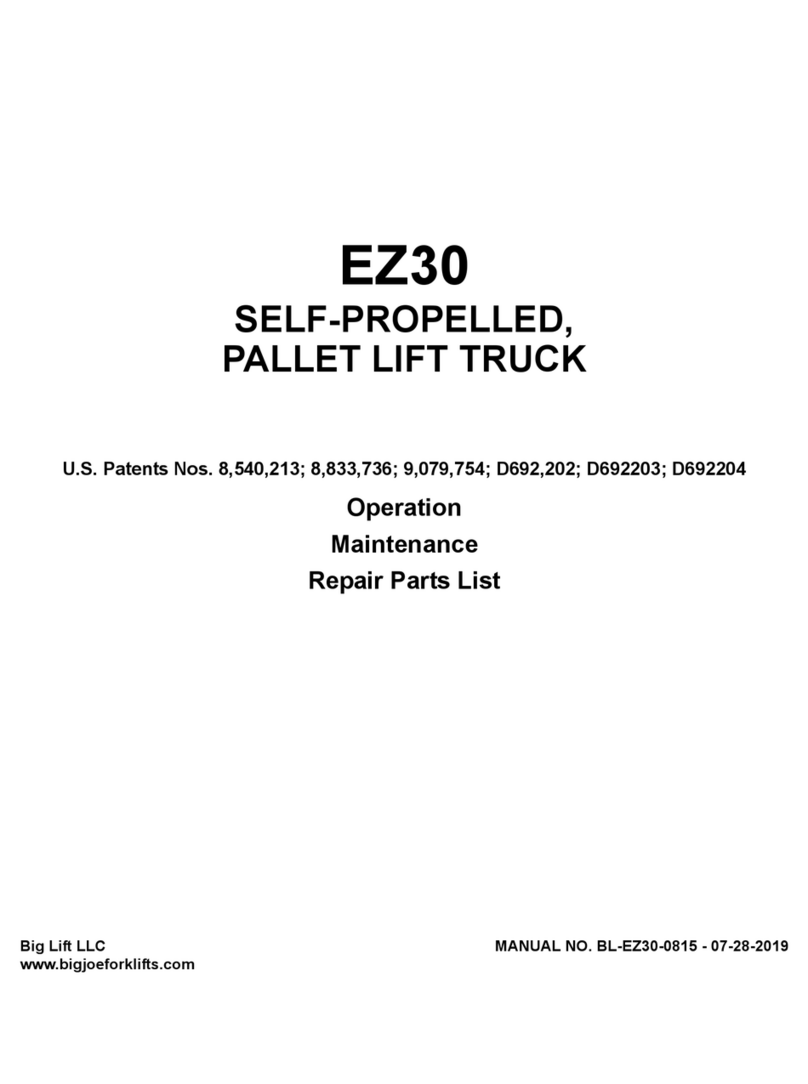
Big Joe
Big Joe EZ30 Use and care manual
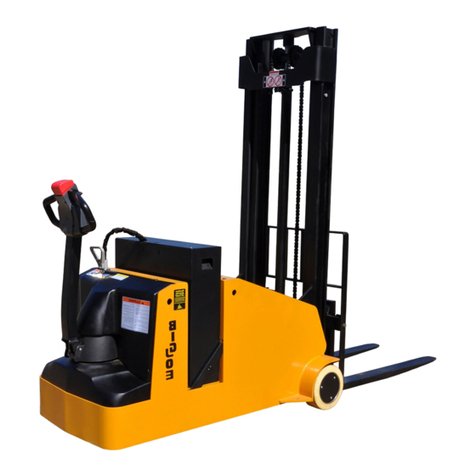
Big Joe
Big Joe CB22 User manual
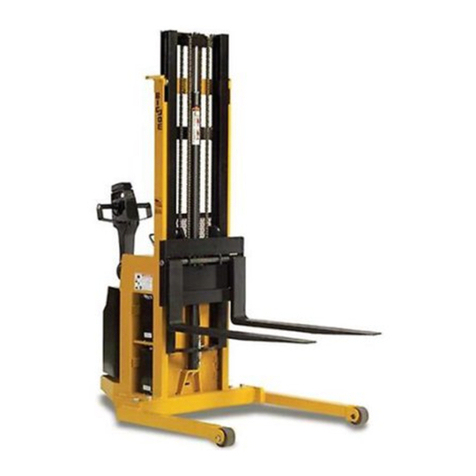
Big Joe
Big Joe PDI Series User manual
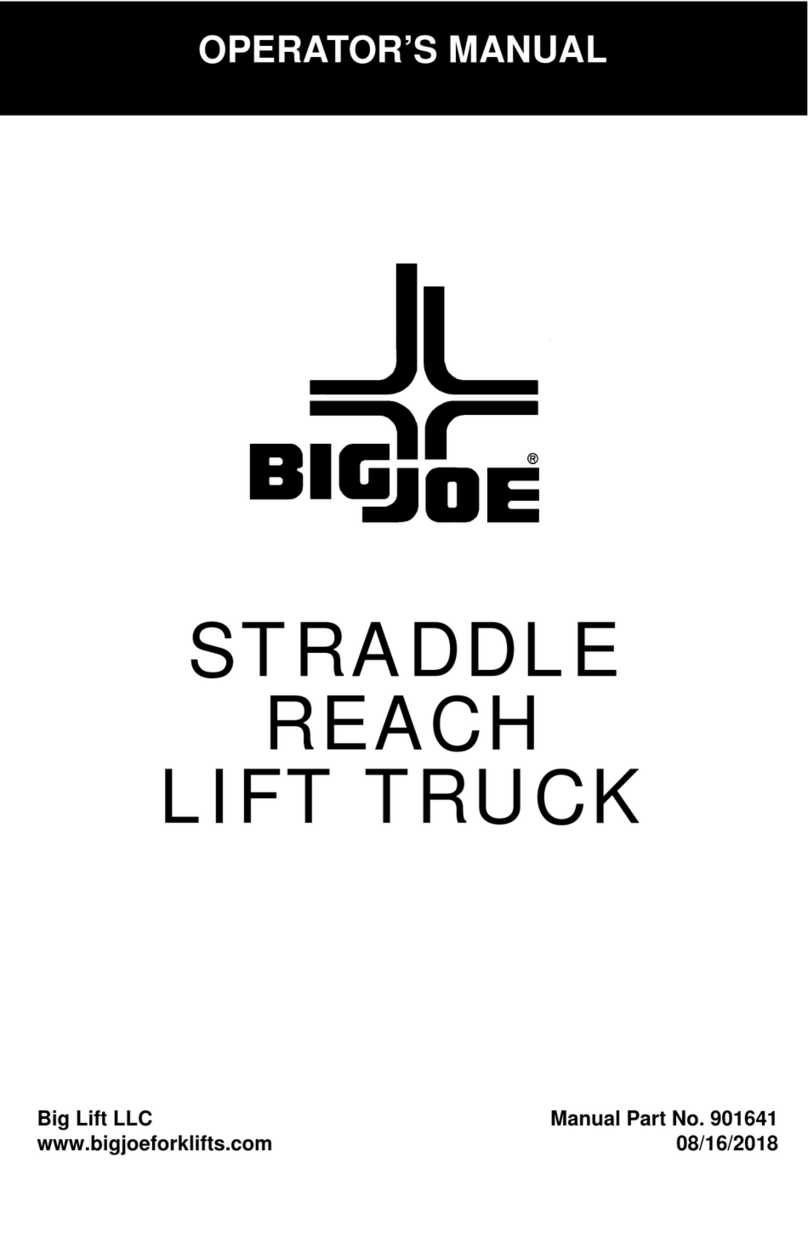
Big Joe
Big Joe PDSR User manual

Big Joe
Big Joe E30 User manual
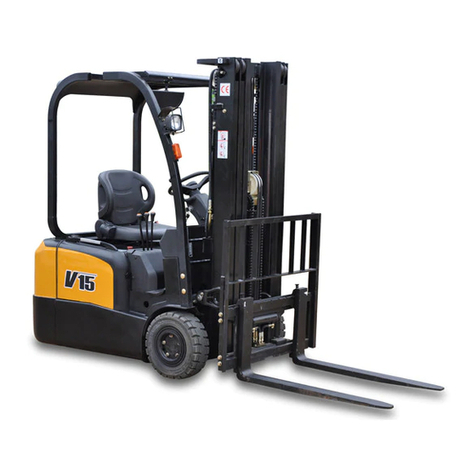
Big Joe
Big Joe V Series User manual

Big Joe
Big Joe T15 User manual
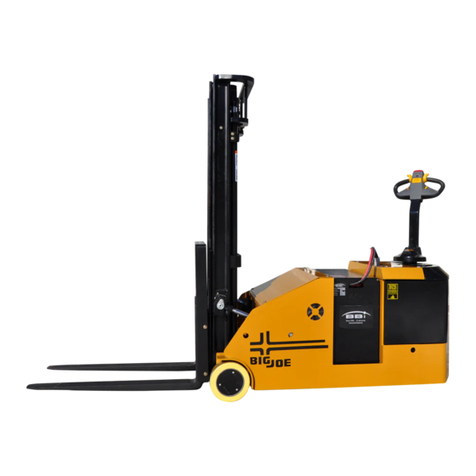
Big Joe
Big Joe CB33 User manual
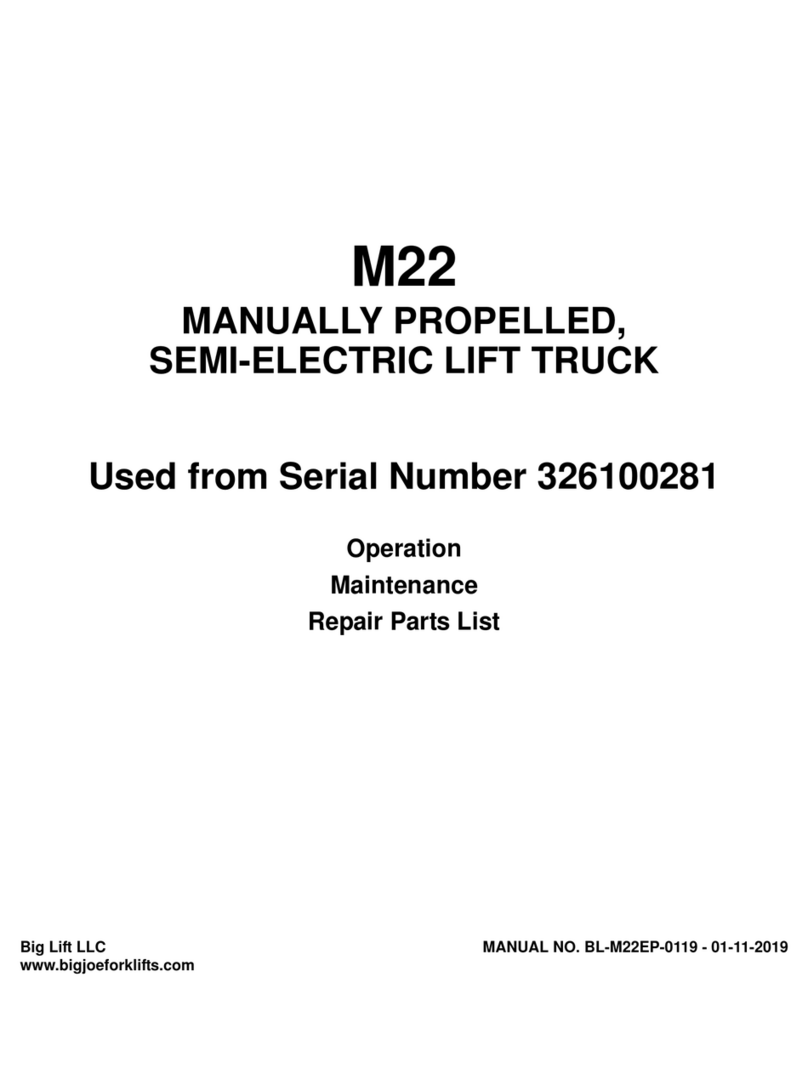
Big Joe
Big Joe M22 Use and care manual

